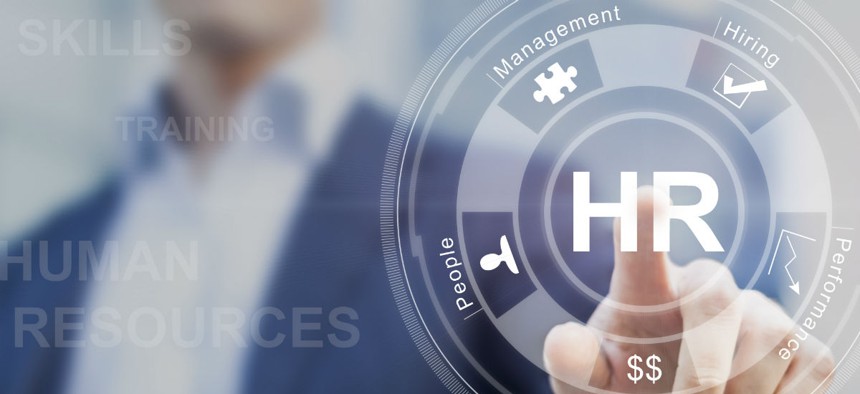Imagine the Possibilities of Real HR Reform
The HR function costs the federal government just under $2,000 per civilian employee, compared with approximately $1,400 in the private sector.
Most discussions about improving federal personnel management turn to civil service reform, employee engagement, performance management, FEVS scores, workforce planning, and strategic partnering. While transformational activity must continue in these areas, it is time to look at human resources differently.
The HR function costs the federal government just under $2,000 per civilian employee, compared with approximately $1,400 in the private sector. That’s with a government HR staff ratio of about 1:47, compared with a private sector ratio of about 1:100. Given the statutory requirements, regulations, processes, oversight, merit principles, etc., involved in federal personnel management, this may be appropriate. But what if we could streamline HR and still meet all these requirements?
There is technology being designed that, if executed with forethought and planning, appropriate investment, unencumbered bureaucracy and effective user-centric tools, could provide a foundation for dramatic change in the way government manages HR. It would also give employees more control over their own careers.
The Office of Personnel Management is currently planning and building an Electronic Employee Record using advanced blockchain and other technologies. The plan, supported by President Trump’s recently released management agenda, is to provide advanced data capacity and could support a near paperless approach to HR. If designed correctly, it will provide the foundation for a radical shift and put the government on a path to transforming HR efficiency and effectiveness. It can change the world of HR with two simple focal points.
Focus on the employee. In this new world, paper would be a thing of the past. From hiring to retiring, the focus would be on people rather than forms and policy. Pertinent information for a new federal employee is entered into the system once and never has to be repeated on a form again. Self-service updates and changes such as a new mailing address, adding a new dependent, or changing retirement investment choices are made on a mobile app by the employee. Job transfers to new agencies or promotions are done with a quick update to the system and a notification is sent to all parties on a smartphone.
Retirement adjudication would be done electronically, and not through error-prone, labor-intensive, time-consuming actions and processes. From an employee’s first day on the job, the system tracks all career events that impact retirement. When it is time to retire, the employee tells the system and everything is accomplished electronically—start date is established, signatures are sought and made, compensation amounts are calculated, and the employee is automatically transferred to the annuitant pool.
Imagine logging into a tablet to do career planning with a system that can show career maps based on historic data in the same or similar occupations, providing you with a path and indicators of success, along with a planning tool.
Focus on the HR systems and processes. In this new world, data and algorithms would drive certain HR and human capital functions and activity to ensure efficiency and effectiveness. At a basic level the traditional HR data analytics activity is provided on real-time dashboards for managers. Attrition rates, demographic data, geographic information, protected group participation, bench strength, education, supervisory ratios, skill levels, workload, etc., could be automatically profiled and reported, allowing agencies to properly align their workforce.
But let’s take this a bit further. Imagine if the federal HR system was linked to census, labor, workload, performance, and national compensation data to conduct labor pool or compensations trends and comparisons, sliced and diced in real time. You could find pockets of needed expertise, understand local labor markets, and plan for occupationally-based pay.
Imagine if data could be used to speed the recruiting and hiring process using artificial intelligence to identify and select the strongest candidates or develop an effective recruitment strategy and quickly develop and catalog position descriptions through a standard template. A system where you could easily compare hiring times for regular or hard-to-fill positions by geography, skill level, occupation, gender, or any other data point. Imagine if schools could use federal data to prepare their students for careers in government.
Imagine using a system to help government predict trends in the workforce and future needs, and conduct real-time workforce planning. A lot of agencies conduct time consuming and costly workforce planning that mostly provides a point-in-time snapshot of the workforce and its anticipated needs, with a short shelf life. Imagine the system alerting you when planning is necessary due to changes on the horizon. Imagine a system that could help with decision-making around permanent, temporary, detailed or contract personnel, and that shared effective human capital strategies across government.
I could keep going with many more examples, but I think you understand my point—HR could be paperless, accessible, predictive, and less expensive. We could refocus valuable resources on the mission and on creating a great place to work.
Steve Goodrich is the CEO of the Center for Organizational Excellence and author of Transforming Government from Congress to the Cubicle. He can be reached at sgoodrich@center4oe.com.








